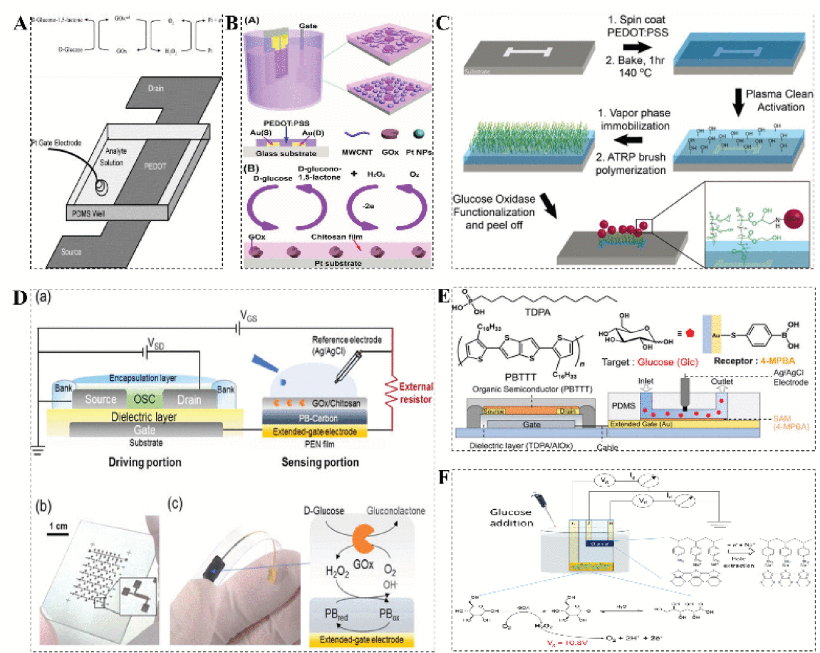OFET and OECT, Two Types of Organic Thin-Film Transistor Used in Glucose and DNA Biosensors: A Review
Diabetes is a significant global health challenge, and if left untreated, it often causes other chronic diseases. Real-time glucose monitoring for effective prediction and management is crucial. Genetic factors also contribute to diabetes development, thus making DNA testing a valuable tool in predicting genetic risk factors for early intervention.
Recent advancements in glucose monitoring have focused on creating non-invasive, wearable, continuous, and point-of-care solutions. Organic electronics, particularly Organic Thin-Film Transistors (OTFTs), have emerged as promising tools for detecting glucose and DNA biosensors.
The paper comprehensively analyzes the latest OTFT biosensors, including their working principles, fabrication processes, and performance.
OTFT, a three-electrode device, functions like a capacitor with charges accumulated at the interface between the insulator and semiconductor layers. It controls the current flow between two electrodes (source and drain) by applying a voltage to the third electrode (gate).
Two types, Organic Field Effect Transistors (OFETs) and Organic Electrochemical Transistors (OECTs), have recently been getting attention as biosensors. OFETs operate like conventional OTFT devices, manipulating conductivity in the semiconductor material based on gate voltage. OECTs detect changes in the electrical properties of organic materials due to variations in the doping level of biological analytes, specifically in poly(3,4-ethylene-dioxythiophene) doped with polystyrene sulfonate (PEDOT: PSS).
OFET sensors use P-type organic semiconductors, which are entirely degradable and cost-effective. Their simplicity, compatibility with flexible substrates, and lack of additional markers make them ideal for wearable biosensors. A powerful biological recognition capability of OFETs enables precise detection of biomolecules such as glucose and DNA in diabetes precision medicine.
OECTs show very steady performance in aqueous environments, making them ideal for applications in biosensors for glucose and DNA as non-invasive body fluid sensing tools.
A microfluidic platform using extended gate OFETs developed for real-time blood glucose monitoring showed excellent stability. Another OECT-based biosensor for selective glucose and lactate detection showed a response within the range of 0.1-8.0 mM.
OTFT is also effective at detecting DNA in diabetic genetic risk assessments. A novel OTFT biosensor employs pentacene as a semiconductor and SiO2 as an insulating layer for DNA immobilization, causing a threshold voltage shift. This allows differentiation between single-stranded and double-stranded DNA based on their immobilization efficiencies. The system integrates an active layer with PEDOT: PSS and an OECT with a gold gate electrode, all within a microfluidic channel, marking a significant advancement in DNA detection technology for speed, flexibility, and efficiency.
Researchers have explored plasma treatment of 2D channel materials as a potential technique to enhance the electrical properties of FET devices. This treatment reduces residues on graphene surfaces, improving affinity between target and probe DNA, thereby enhancing sensitivity in DNA hybridization detection.
Compared to traditional sensors, OFET and OCET biosensors offer advantages like smaller sensitive areas, lower detection limits, wider detection ranges, better reproducibility and stability, higher sensitivity, and easy integration with circuits. Their biocompatibility, low operating voltages, and flexibility on substrates suggest broad applications in flexible biosensors.
Innovations in fabrication technology and new materials will further increase the performance and sensitivity of OTFT glucose and DNA biosensors.




